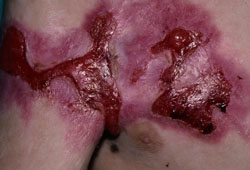Summary
Definition
History and exam
Key diagnostic factors
- positive family history of epidermolysis bullosa (EB)
- mechanical fragility of the skin
- recurrent blisters and erosions
- poorly healing wounds
- onset of cutaneous signs at birth or early infancy
- resolution of blistering within the first 1-2 years of life
- generalized or localized distribution of skin involvement
- combination of milia, scarring, and dystrophic nails
- absence of milia, scarring, and dystrophic nails
- exuberant granulation tissue
- herpetiform blistering
- pseudosyndactyly
- enamel hypoplasia
- reticulate hyperpigmentation
- muscular dystrophy
- tracheolaryngeal stenosis or stricture
- severe upper airway disease
- onset in mid or late childhood
- inverse (intertriginous), acral, or centripetal distribution of skin involvement
- severe cardiomyopathy
Risk factors
- Family history of EB
Diagnostic tests
1st tests to order
- immunofluorescence antigenic mapping
- DNA mutational analysis
- transmission electron microscopy
Treatment algorithm
suspected tracheolaryngeal stenosis, stricture, or obstruction
suspected systemic infection
EBS, JEB, DEB, Kindler EB
Contributors
Authors
Ajoy Bardhan, BSc, MBBS, MRCP
Clinical Lecturer in Dermatology
Honorary Consultant Dermatologist
Birmingham Medical School
University of Birmingham
University Hospitals Birmingham NHS Foundation Trust
Birmingham
UK
Disclosures
AB has previously given a sponsored lecture titled Skin Microbiome 101 at a "Beauty of the Skin" Educational event sponsored by La Roche Posay, is an author of one or more references cited in this topic, and has also attended a non-promotional educational lecture program funded by Amryt Pharmaceuticals.
Acknowledgements
Dr Ajoy Bardhan would like to gratefully acknowledge Professor Jo-David Fine, the previous contributor to this topic.
Disclosures
JDF is an author of a number of references cited in this topic.
Peer reviewers
Helmut Hintner, MD
Professor and Chair
Department of Dermatology
Paracelsus Private Medical School
Salzburg
Austria
Disclosures
HH is an author of a reference cited in this topic.
Nanette Silverberg, MD
Clinical Professor of Dermatology
Columbia University College of Physicians and Surgeons
New York City
NY
Disclosures
NS declares that she has no competing interests.
Peer reviewer acknowledgements
BMJ Best Practice topics are updated on a rolling basis in line with developments in evidence and guidance. The peer reviewers listed here have reviewed the content at least once during the history of the topic.
Disclosures
Peer reviewer affiliations and disclosures pertain to the time of the review.
References
Key articles
Has C, Bauer JW, Bodemer C, et al. Consensus reclassification of inherited epidermolysis bullosa and other disorders with skin fragility. Br J Dermatol. 2020 Oct;183(4):614-27.Full text Abstract
Fine JD, Bruckner-Tuderman L, Eady RA, et al. Inherited epidermolysis bullosa: updated recommendations on diagnosis and classification. J Am Acad Dermatol. 2014 Jun;70(6):1103-26.Full text Abstract
Has C, Liu L, Bolling MC, et al. Clinical practice guidelines for laboratory diagnosis of epidermolysis bullosa. Br J Dermatol. 2020 Mar;182(3):574-92.Full text Abstract
Has C, El Hachem M, Bučková H, et al. Practical management of epidermolysis bullosa: consensus clinical position statement from the European Reference Network for rare skin diseases. J Eur Acad Dermatol Venereol. 2021 Dec;35(12):2349-60.Full text Abstract
Reference articles
A full list of sources referenced in this topic is available to users with access to all of BMJ Best Practice.

鉴别诊断
- Epidermolytic hyperkeratosis (bullous congenital ichthyosiform erythroderma)
- Congenital porphyrias
- Cutaneous absence of skin (aplasia cutis)
More Differentials指南
- Consensus reclassification of inherited epidermolysis bullosa and other disorders with skin fragility
More 指南登录或订阅即可浏览 BMJ Best Practice 临床实践完整内容
内容使用需遵循免责声明